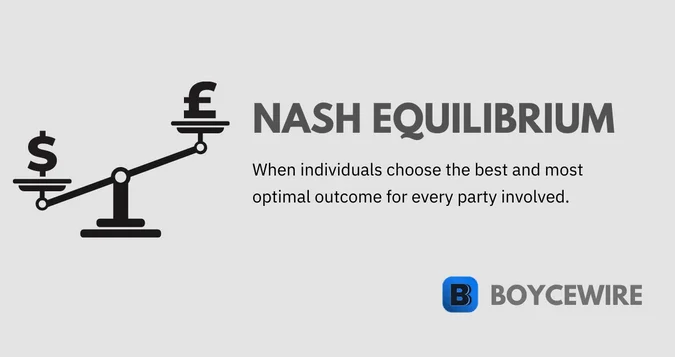Table of Contents ![]()
Nash Equilibrium: Definition & Examples

What is the Nash Equilibrium?
Nash equilibrium refers to the situation whereby a group of individuals choose the most optimal strategy and do not deviate from that initial decision. Individuals stick to the initial decision in the knowledge that all other options are inferior.
The Nash equilibrium is often used in a game setting but is also applicable to real-life scenarios. Originally conceptualized by mathematician John Forbes Nash Jr., it was designed to explain the decision making in non-cooperative games involving two or more players.
There is Nash equilibrium when Player A chooses strategy 1 and Player B chooses strategy 2 – if Player B has no other option that would maximize their outcome. In other words, Player B chooses the next best option – thereby maximizing the outcome for all parties.
Key Points
- The Nash equilibrium is where all players choose the option that is the most positive outcome for each party.
- A Nash equilibrium occurs when players do not change their decision even after knowing the other players.
- Adam Smith stated that individuals following their own interest would produce socially optimal results. However, the Nash equilibrium states that the optimal results are only achieved when the group is considered.
The Nash equilibrium is a core part of Game Theory whereby players choose the best option available to them. This is an important theory in economics as it has wider-reaching effects. For example, at traffic lights, participants operate at the Nash equilibrium. Those who are on green will go as that is the best option for them, whilst those who are on red will stop – as the alternative would be to crash into another car. According to the substitution effect, consumers will go to a competitor such as Burger King – assuming its prices stay the same.
When applied to economics, the Nash equilibrium can help us decide whether government intervention is necessary or whether the market will be able to self-regulate. For instance, do subsidies really help provide lower costs to consumers, or, do they prevent businesses from going bankrupt and thereby prevent new, more efficient businesses from taking their place.
Nash Equilibrium Example
Prisoner Dilemma
The prisoner’s dilemma is a common example of the Nash equilibrium. There are two criminals who have been arrested, but the prosecutors have little evidence against them. They separate both criminals into their own cell and ask them to confess. In return, the prosecutors wont press charges and they will be allowed to go free. However, if the other confesses, then they will spend 10 years in prison. For example, if Prisoner 1 confesses, then Prisoner 2 will go to jail for 10 years if they too do not confess. If both confess, then they both go to prisoner for 7 years. Yet if neither confess, then they only go to prisoner for 1 year each as there is insufficient evidence.
The Nash equilibrium is only achieved when there is an optimal outcome for both parties. In other words, both parties do not deviate from their original decision once they know the other players choice. In this case, the Nash equilibrium occurs when they both confess. Both prisoners do 7 years, but would do 10 years if they lied. Therefore, when considering the other players decision, this is the most optimal outcome.

It must be said that both prisoners would be better off lying and only receiving one year each. However, that is sub-optimal when the prisoners are aware of the others decision. They could then lie and avoid prison altogether. So from a selfish point of view, it would make sense for them to lie. In turn, this demonstrates the importance of co-operation to achieve the most desired outcome for both parties. They would both benefit if the other lied, yet they cannot be sure the other will do so. Both prisoners could end up with 10 years if the other confesses, but this is reduced to 7 if both confess. So whilst confessing it is sub-optimal, it guarantees the prisoner will not spend 10 years in prison.
Nash Equilibrium Limitations
Nash Equilibrium is intrinsically linked with game theory, but it has many limitations. Some of these can be seen below:
1. Rationality Assumption
First of all, the Nash Equilibrium assumes that players are rational enough to choose the most optimal strategy. However, in the real-world, the situation is much more complex. Individuals have emotions and cognitive biases, as well as limited information, which contribute to their inability to make rational decisions. Therefore, the equilibrium predictions are unlikely to reflect what it is like in the real-world.
2. Multiple Equilibria
In some games, there are multiple Nash Equilibria. This can result in issues between players in coordinating to achieve the desired outcome. In such situations, it can be confusing for all players involved. It is equally confusing to predict what other players will perceive as the most desired outcome. Each individual may have different preferences, which can lead to the ambiguity which makes it difficult to apply the concept on Nash Equilibrium.
3. No Pure Strategy Equilibria
Sometimes in game theory, there are no pure strategy Nash Equilibria, and only mixed strategy equilibria exist. This means players have to randomly choose instead of sticking to one strategy. It can make understanding the equilibrium more difficult.
4. Suboptimal Outcomes
Nash Equilibrium doesn’t always produce socially optimal or efficient results, as seen in the Prisoner’s Dilemma. Sometimes, Nash Equilibrium can be Pareto inefficient. This means there could be another outcome where at least one player benefits without causing any harm to others.
5. Static Nature
The Nash Equilibrium is a static idea, which shows the optimal strategic outcome only at a particular time. Games are often dynamic, so these ideal outcomes can change as the game progresses. Examples might include where games are repeated, or where the players have incomplete information.
New concepts such as sub-game perfect equilibrium, Bayesian-Nash equilibrium, and perfect Bayesian equilibrium, go some way to address the limitations of the Nash Equilibrium. These new concepts consider beliefs, sequential rationality, and updating of information. Yet for the time being, Nash Equilibrium continues to remain one of the most widely used concepts in game theory – helping understand strategic decision making.
Nash Equilibrium vs. Dominant Strategy
In game theory, both Nash Equilibrium and Dominant Strategy are important concepts. Let’s look at how they both compare below:
Nash Equilibrium
A Nash Equilibrium occurs when no player can improve their situation, considering the strategic choices of the other players. In other words, each player chooses a strategy which produces the best outcome when considering the strategies chosen by the other players. The Nash Equilibria that results can occur in simultaneous or sequential games, with some situations providing multiple Nash Equilibria, or, on occasion, none at all.
Dominant Strategy
A Dominant Strategy is a strategy that yields the highest payoff for a player regardless of the strategies chosen by the other players. If a player has a dominant strategy, they will always choose that strategy as it guarantees the best possible outcome for them in any scenario. Dominant strategies are not always present in a game, and not all players may have a dominant strategy.
Comparison:
- A Nash Equilibrium is more general and can occur in games with or without dominant strategies. In contrast, a dominant strategy specifically refers to a situation where a player has a single best strategy regardless of their opponents’ choices.
- If every player in a game has a dominant strategy, the combination of those dominant strategies will form a Nash Equilibrium. However, not all Nash Equilibria involve dominant strategies.
- Nash Equilibrium is a broader concept that applies to a larger range of games, while dominant strategies are specific to particular situations within games.
- The existence of a dominant strategy simplifies the decision-making process for a player, as they don’t need to consider the strategies of other players. In contrast, identifying a Nash Equilibrium often requires considering the strategies of all players in the game.
In summary, a dominant strategy is a specific type of Nash Equilibrium where each player has a best strategy that always leads to the highest payoff, regardless of the other players’ strategies. However, not all games have dominant strategies, and Nash Equilibria can exist even without the presence of dominant strategies in the game.
FAQs
Nash Equilibrium is a solution concept in game theory that occurs when each player in a game has chosen their optimal strategy, given the strategies chosen by the other players. In a Nash Equilibrium, no player can improve their payoff by unilaterally changing their strategy.
Nash equilibrium can be found where neither participant can better their current position based on the other players position.
Nash equilibrium is important as it expands on Adam Smiths theory that individuals pursuing their own individual interests benefit society. Instead, it shows that the most socially optimal point is where individuals meet at the Nash equilibrium, which often involves individuals coming together and co-operating to bring this about.
The most common example of the Nash equilibrium is that of the prisoner’s dilemma. There are two prisoners who have been taken in and separated by the prosecutors. There isn’t enough evidence to charge them of serious crimes, but there is enough to sentence them to one year in prison. The prosecutors offer both prisoners a get out of jail pass if they confess and implicate the other prisoner. There are four possible outcomes:
– Prisoner 1 confesses and receives 0 years. Prisoner 2 lies and receives 10 years.
– Prisoner 1 lies and receives 10 years. Prisoner 2 confesses and receives 0 years.
– Both Prisoners 1 and 2 confess, with both receiving 7 years.
– Both Prisoners 1 and 2 lie, only receiving 1 year each.
The most optimal result would occur if they both lie and only receive 1 year. However, that requires a level of co-operation between the two which isn’t achievable in the circumstances.
The Nash equilibrium is where both prisoners could not improve on their position given the other chosen course of action.
Nash Equilibrium is a fundamental concept in game theory, a field that studies strategic interactions among rational decision-makers. It provides a framework for understanding and predicting the behavior of players in various contexts, such as competition, cooperation, and negotiation.
About Paul
Paul Boyce is an economics editor with over 10 years experience in the industry. Currently working as a consultant within the financial services sector, Paul is the CEO and chief editor of BoyceWire. He has written publications for FEE, the Mises Institute, and many others.

Related Topics
Further Reading
 Elastic Demand - Elastic demand refers to a situation where a change in price results in a relatively larger change in quantity demanded.
Elastic Demand - Elastic demand refers to a situation where a change in price results in a relatively larger change in quantity demanded.  Retained Earnings: Definition, Formula & Example - Retained earnings are the amount that a firm keeps after it has distributed dividends to shareholders.
Retained Earnings: Definition, Formula & Example - Retained earnings are the amount that a firm keeps after it has distributed dividends to shareholders.  Commodity Money: What it is, Why it has value & Examples - We can define Commodity money as a physical good that consumers universally use to trade for other goods. In other…
Commodity Money: What it is, Why it has value & Examples - We can define Commodity money as a physical good that consumers universally use to trade for other goods. In other… 